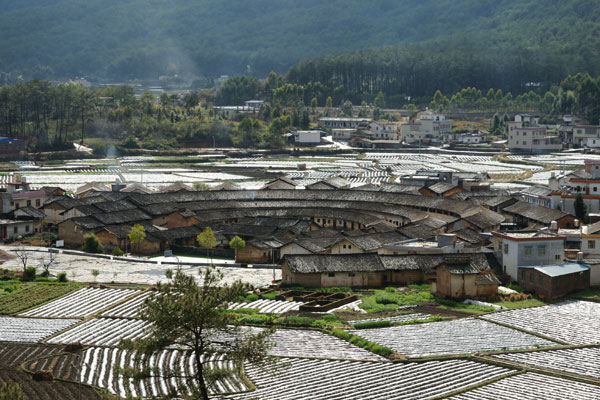A world of their own
 |
|
Weiwu (self-encircling houses) scattered in Meizhou, Guangdong province, are one of the most visible examples of the Hakka way of living.[Photo by Huang Lingbo/for China Daily] |
The Hakka people were constantly in search of a better life. Many emigrated farther away to Southeast Asia and other destinations. There are some 10 million who now live overseas. In the old town of Songkou, there is an old bridge, constructed with donations from former residents who had made it overseas, one can still detect faint traces of the town's glory days.
|
|
|
Home-style cuisine packs a punch in warmth of family gathering |
Songkou is quite dilapidated. The river has long ceased its function as a channel for transportation and thus a gateway to the outside world. The street closest to the river is the only one that has kept its original architecture, now in ubiquitous decay. But many microfilms set their stories, or at least the opening shot for location, in this town. (The purpose of my trip to Meizhou and its vicinity was to serve on the jury for a film competition that promotes the Hakka culture.)
While the weiwu demonstrates Hakka's inward-looking and self-protecting nature, the Meijiang River, which runs through many Hakka-inhabited towns, is a silent witness to the adventure seekers who broke free of the conventions and shackles in pursuit of their dreams. The Hakka played crucial roles in many uprisings and revolutions.
The most celebrated nowadays is Ye Jianying (1897-1986), a Communist general whose trips back home are depicted in enlarged photographs festooning his ancestral household. The compound is a fraction of the size of a typical weiwu but also home to an extended family.
A much bigger home I visited was that of Huang Zunxian (1848-1905), a poet, educator and diplomat whose support for reform caused his downfall from official grace during the Qing Dynasty (1644-1911). His efforts to protect the interests of overseas Chinese and improve their education is the stuff of legend among those who settled abroad. Now his residence serves as a gallery for plaques of all kinds.
If you find Cantonese hard to comprehend, you may be surprised that the Hakka dialect is easier to understand. That's because it comes from the dialects of Henan province, which was more or less solidified in the Southern Song Dynasty (1127-1279). Use Hakka to read ancient poems and you'll realize many of the rhymes suddenly make sense.
As a matter of fact, the Hakka dialect could be living proof of how much of the Central Plains culture has been retained and how much assimilation with the southern culture has taken place. Before mass migration becomes a daily occurrence, the Hakka's perseverance in carrying on ways of old has turned it into a museum of sorts.
If you go
Meizhou has a small airport that serves only a few destinations, including Guangzhou, Shenzhen, Zhuhai, Hong Kong and Taipei. But there is a bigger airport two hours to the south in Chaoshan that links tomanymore Chinese cities. Of course you can alwaysmake it a side trip fromGuangzhou or Shenzhen, riding a bus for four hours and taking in the gorgeousmountain views and air.
The Hakka Park, about 10minutes fromdowntown Meizhou, is a resort hotel attached to a theme park. Tucked away at the foot of a hill, it offers villas suitable for summer retreat and deluxe rooms with curved corridors. The best thing it offers is a walk through the park and even up the hill where a cluster of Disneystyle architecture conjures up the best of the Hakka experience, includingmany restaurants and souvenir shops.
Instead of the hustle and bustle of city traffic, you’ll get themelody of birds chirping and themurmur of running water —plus the occasional hotel staff member making sure every pebble is impeccably clean. If you don’t drive, youmaywant to pick any of a dozen hotels in the old town area and savor evening snacks along the streets.






















